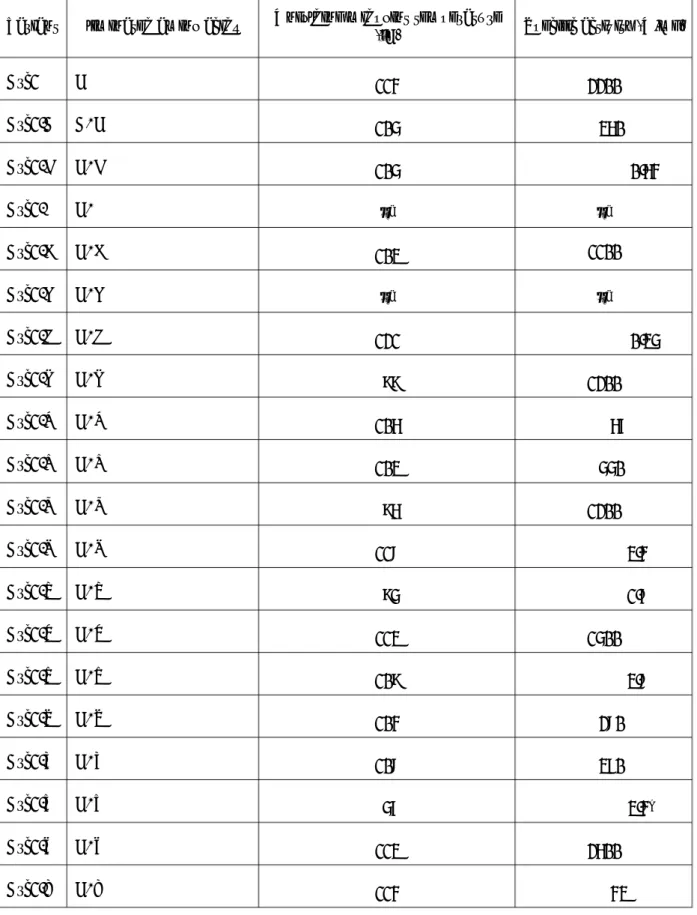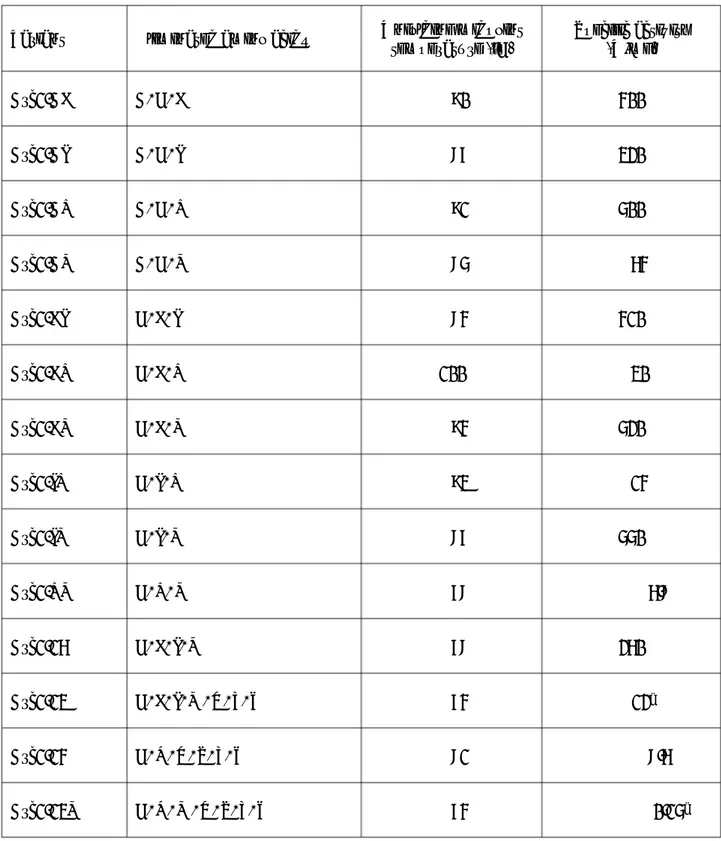ACIDS IN PRIMITIVE PROTEIN SYNTHESIS Rei Shibue
1, Satoshi Akanuma
1,21
Faculty of Human Sciences, Waseda University, 2-579-15 Mikajima, Tokorozawa, Saitama 359-1192, Japan
2
Corresponding author: Faculty of Human Sciences, Waseda University, 2-579-15 Mikajima, Tokorozawa, Saitama 359-1192, Japan.
Tel, +81-4-2947-6727; fax, +81-4-2947-6811;
email, akanuma@waseda.jp
(Received: July, 26, 2018 Accepted: September, 2, 2018)
Abstract
Contemporary organisms commonly use the genetically encoded 20 amino acids to synthesize proteins.
However, earlier protein synthesis was plausibly much simpler and utilized a subset of the standard proteinogenic amino acids. We reconstructed ancestral nucleoside diphosphate kinases (NDKs) by combining the computational inference of ancestral sequence and a whole gene synthesis technique. One of the reconstructed NDKs, Arc1, is an extremely thermally stable protein with the unfolding midpoint temperature of 114°C and the magnitude of its specific activity is comparable with those of extant NDK. Arc1 lacks cysteine and therefore consists of 19 amino acid letters.
To address simpler constituents for primitive proteins, we comprehensively reduce the size of the amino acid alphabet in Arc1 to reduced sets. We found that many but not all of the reduced-set amino acids were consistent with those plausibly abundant in primitive environment. We also found that the remaining inconsistent amino acids were important for activity but not for stability. Our results are compatible with the hypothesis that amino acids available in the prebiotic environment were first used for creating stable protein structures and their functions were later improved by recruiting other amino acids.
Keywords: Ancestral protein, origin of life, origin of translation, primitive amino acid repertoire, primitive proteins, protein simplification, reduced amino acid alphabet
背景
地球上で生息するすべての生物は、核酸重合体 を遺伝物質として持ち、ほとんどの場合、タンパ ク質が機能分子として細胞内外で働いている。
DNA や RNA のような核酸の重合体は、タンパク 質のアミノ酸配列を指定する情報を持ち、タンパ ク質はDNAの複製や転写によるRNA合成に関わ っている。したがって、生命の起源に関連して、「核 酸が先か?タンパク質が先か?」という問いの解 明が長年の課題であった。しかし、非生物的 RNA 重合 [1,2]、リボザイムによって触媒された RNA 複製 [3]、自身の鏡像異性体を合成するリボザイム の発見により [4]、タンパク質の誕生に先んじた RNA ワールド仮説が支持を得てきた。次の課題と なるのがRNAワールドにどのようにしてタンパク 質が誕生したかである。
初期のタンパク質合成系に使われたアミノ酸 種類についての議論は、遺伝暗号の起源と進化に 関する議論と密接に関連する。DNAの二重らせん モデルの提唱者の一人であるCrickは、現在の標準 遺伝暗号表の成立は偶然に依ることが大きいとす る「偶然凍結説」を唱えた [5]。それに対して、標 準遺伝暗号表の成立に合理的な説明を与えようと したいくつかの理論が提唱されてきたが、それら は必ずしも一致しない [6-10]。しかし、それらの 理論は共通して、初期の遺伝暗号表は20種類より も少ないアミノ酸だけを指定していて、進化の過 程で徐々に指定されるアミノ酸が増加して、最終 的に現在の20種類に至ったと説明している。初期 の地球環境を模した環境を実験室内で再現し、放 電実験をおこなったミラーの実験における生成物 や、隕石の分析から示されたアミノ酸組成から、
標準遺伝暗号表で指定された20種のアミノ酸の一 部だけが前生物的環境下でも存在していたと推定 されている [11-16]。さらに、どのようにして 20 種類のアミノ酸が選ばれたのかについても議論が おこなわれてきた [17-20]。
しかし、たとえ初期のタンパク質が20種類未 満のアミノ酸だけから合成されていたとしても、
そのタンパク質は、何らかの機能を示す程度には 安定な構造を形成したはずである。現在までも、
必ずしも 20 種類のアミノ酸が揃っていなくても、
天然様立体構造を形成すること、あるいは、触媒 機能を持ったタンパク質を合成することが可能で あることが示されてきた [21-24]。しかし、これら の研究で少数種アミノ酸から合成されたタンパク 質の多くは触媒機能を持たなかったり、安定な立 体構造を形成しなかったりした。さらに、ほとん どの場合、少数種アミノ酸は恣意的に選ばれてき た。
現在、急速に増えている生物のゲノムデータ を比較することで,過去のタンパク質配列を予測 し、復元することが可能となった。筆者らは、こ の技術を利用して祖先生物のヌクレオシド二リン 酸キナーゼ(NDK)配列を推定・復元した [25,26]。
復元した祖先型NDKの一つであるArc1は、変性 中点温度が 114℃と極端に熱安定なタンパク質で あり、その結晶構造から同一のサブユニット6個 が会合した六量体構造が明らかになっている [25]。
Arc1はシステインを含まず、19種類のアミノ酸か ら構成されている。本稿では、系統的に選択され た少数種アミノ酸からタンパク質を合成した筆者 らの最新の研究 [27] について紹介する。すなわち、
筆者らは、安定な立体構造形成能や触媒活性を失 わせることなく、Arc1を構成するアミノ酸種を20
種類から徐々に減らしていくことによって、安定 で触媒活性を持つNDKを再構成するのに必要な少 数アミノ酸種類を明らかにした。さらに、地球化 学的な研究から前生物環境下に存在したと推定さ れているアミノ酸種と比較した。
アミノ酸種を欠損させた Arc1 改変体の安定性と触 媒活性
筆者らは、最初にシステインを除く19種類のア ミノ酸のうちの1種を欠損させた 19 種類の Arc1 改変体を再構成した。Arc1 はシステインを持たな いので、いずれの改変体も18アミノ酸種で構成さ れている。アミノ酸を欠損する際には、現存の309 個のNDK配列の多重アライメントを参考にし、欠 損させるアミノ酸をその座位に最も多く見られる 別のアミノ酸種に置換した。筆者らは、ある座位 に最も高頻度で出現するアミノ酸種は、NDKの進 化においてその座位に最も適しているアミノ酸と して選択されてきたと考えた。加えて、高頻度で 出現するアミノ酸は、タンパク質の安定性にも寄 与することが多いことも知られている [28]。元の アミノ酸が多重アライメント中に含まれる現存 NDKにおいて完全に保存されている場合は、側鎖 の物理化学的性質が最も似ているアミノ酸に置換 した。メチオニンの欠損に際しては、N 末端残基 は考慮しなかった。Table 1に示したように、グリ シンまたはグルタミン酸を欠損させた改変体(す なわち、システインとグリシンを持たないか、あ るいは、システインとグルタミン酸を持たない 18 種類のアミノ酸で構成された改変体)は可溶性タ ンパク質として得られなかったので、それ以上の 解析をおこなわなかった。恐らく、グリシンとグ ルタミン酸はArc1のフォールディングや熱力学的 安定性に大きく寄与している、安定な立体構造形 成に重要なアミノ酸であると思われる。残りの 17 改変体の熱安定性を解析するため、それぞれの改 変体について、タンパク質中の α へリックス含量 の指標となる222 nmの楕円率の温度変化を測定し た。さらに、観測された熱変性曲線から、変性中 点温度を求めた。それぞれの改変体について、70℃
における比活性も求めた(ただし、バリンを欠損 させた改変体の比活性は 50℃で測定した)。NDK はヌクレオシド三リン酸の γ リン酸基をヌクレオ シド二リン酸に転移する反応を触媒する。 Table 1 にまとめたように、いくつかのアミノ酸種を欠損 させるとArc1の安定性や比活性が大きく低下した。
特にバリンの欠損は、安定性と活性の両方に影響 した。アスパラギン酸、ヒスチジン、アスパラギ ン、アルギニンのうちの1種を欠損させても安定 性には大きな変化は見られなかったが、比活性は 大きく低下した。プロリンまたはチロシンの欠損 は、Arc1の触媒活性を低下させた。それに対して、
残りの10アミノ酸種のうちの1種を欠損させても、
Arc1 の安定性や活性に大きくは影響しなかった。
次に、これらの10アミノ酸種の中から複数種のア ミノ酸を欠損させた改変体を作製することにした。
複数アミノ酸種を欠損させた改変体の作製
筆者らは、欠損させてもArc1の安定性と比活性 にあまり影響しなかった10アミノ酸種のうち、非 極性アミノ酸であるアラニン、フェニルアラニン、
イソロイシン、ロイシン、メチオニンを対象とし て複数アミノ酸種を同時に欠損させた改変体の作 製と解析をおこなった。非極性側鎖はNDKの触媒
活性に直接は関わっていないと考えたからである。
アラニン、フェニルアラニン、イソロイシン、メ チオニンのうちの2種を同時に欠損させた改変体 は、どの組み合わせで欠損させても安定性と比活 性を大きくは劣化させなかった (Table 2) 。しかし、
ロイシンを含む組み合わせで欠損させた場合は、
特 に 比 活 性 へ の 影 響 が 大 き い 傾 向 が 見 ら れ た
(Table 2) 。さらに、アラニン、フェニルアラニン、
イソロイシン、メチオニンのうちの3種を同時に 欠損させた改変体を作製し、それらの変性温度と 比活性を求めたところ、フェニルアラニン、イソ ロイシン、メチオニンを欠損させたArc1-16は変性 中点温度が 78℃と比較的高い熱安定性を維持し、
比活性も 260 U/mg と大きくは低下しなかった
(Table 2) 。
筆者らはさらに、Arc1-16からグルタミン、トレ オニン、トリプトファンを欠損させたArc1-13を作 製し、解析した。その結果、Arc1-13は変性中点温
度が74℃で、50℃における比活性は12 U/mgであ
った (Table 2) 。
次に、別のアミノ酸の組み合わせでの欠損の影 響を調べるため、リジン、グルタミン、セリン、
トレオニン、トリプトファンを同時に欠損させた
改変体 Arc1-14 を合成した。熱変性測定から、
Arc1-14 の変性中点温度は 81℃であることが示さ
れ、70℃での比活性は8.6 U/mgであった(Table 2)。
筆者らは、Arc1-14からさらに他のアミノ酸を欠損 させることを試み、Arc1-14からメチオニンを欠損
させた Arc1-13M の変性中点温度が 74℃で、50℃
における比活性が 0.15 U/mg であることを明らか にした (Table 2) 。したがって、異なる組み合わせ の 13 アミノ酸種だけから構成された2つの Arc1 改変体(Arc1-13 と Arc1-13M)が、70℃を超える 変性温度と検出可能なリン酸基転移活性を持つこ とが分かった。
前生物環境下に比較的豊富に存在したと推定され ているアミノ酸種との比較
Table 3 で、元のArc1とArc1-13、Arc1-13Mの アミノ酸組成を比較した。この表から分かるよう に、Arc1-13とArc1-13Mを構成するそれぞれの13 アミノ酸種のうち、11 アミノ酸種が両改変体で共 通している。そこで筆者らは、両者に共通する 11 アミノ酸種を NDK 合成における「必須アミノ酸」
と呼ぶことにした。次に、必須アミノ酸を、ミラ ーの実験あるいはマーチソン隕石中から検出され たアミノ酸と比較した。原始地球環境を模倣した 条件下で放電による有機物合成をおこなったミラ ーの実験では、標準遺伝暗号表で指定された20ア ミノ酸種のうちの 10 アミノ酸が検出された (Fig.
1) [11,15]。さらに、そのうちの8アミノ酸種がマー チソン隕石からも見つかった (Fig. 1) [13,18]。隕石 中から検出されるアミノ酸を含む有機物は、宇宙 に由来すると考えることができる [29]。マーチソ ン隕石中のアミノ酸組成が前生物的環境下でのア ミノ酸組成を反映していると仮定すると、これら の8アミノ酸種は原始地球環境に比較的豊富に存 在したと考えられる。生物によるアミノ酸生合成 経路誕生以前に存在した原始タンパク質は、環境 中のアミノ酸が重合することで合成されたはずで ある [6]。したがって、ミラーの実験とマーチソン 隕石の両方から検出されたアミノ酸は、原始タン パク質が合成された際に利用可能であったと考え られる。
Table 1. Unfolding temperatures and specific activities at 70ºC of Arc1 and its variants, each devoid of one amino acid letter.
Variant Eliminated amino acids Unfolding midpoint temperature
(ºC) Specific activity (U/mg)
Arc1 C 114 2200
Arc1-A A, C 105 360
Arc1-D C, D 105 0.64
Arc1-E C, E –a –a
Arc1-F C, F 103 1100
Arc1-G C, G –a –a
Arc1-H C, H 121 0.35
Arc1-I C, I 99 1200
Arc1-K C, K 106 67
Arc1-L C, L 103 550
Arc1-M C, M 96 1200
Arc1-N C, N 118 3.4
Arc1-P C, P 95 1.7
Arc1-Q C, Q 113 1500
Arc1-R C, R 109 3.8
Arc1-S C, S 104 280
Arc1-T C, T 108 370
Arc1-V C, V 57 3.4b
Arc1-W C, W 113 2600
Arc1-Y C, Y 114 43
aAppeared to be insoluble.
bSpecific activity of the variant devoid of valine was determined at 50°C.
ミラーの実験とマーチソン隕石から共通して検 出された8アミノ酸のうち、イソロイシンを除く 7アミノ酸が NDK 合成における「必須アミノ酸」
と一致した (Fig. 1)。他の研究グループからも、ミ ラーの実験から検出された10アミノ酸種を主要な 構成成分としたアミノ酸配列が、高塩濃度下で安 定な β-trefoil 構造へと折りたたまれることが報告
されている [30]。したがって、少数種アミノ酸に よる安定で活性を持ったタンパク質の再構成実験 は、原始地球環境に豊富に存在したアミノ酸の推 定を試みた地球化学的な研究を補うことができる はずである。
Table 2. Unfolding temperatures and specific activities at 70ºC of simplified variants devoid of multiple amino acid letters.
Variant Eliminated amino acids Unfolding midpoint
temperature (ºC) Specific activity (U/mg)
Arc1-AF A, C, F 90 400
Arc1-AI A, C, I 87 320
Arc1-AL A, C, L 91 500
Arc1-AM A, C, M 85 64
Arc1-FI C, F, I 84 410
Arc1-FL C, F, L 100 30
Arc1-FM C, F, M 94 520
Arc1-IL C, I, L 93 14
Arc1-IM C, I, M 87 550
Arc1-LM C, L, M 78 6.8
Arc1-16 C, F, I, M 78 260
Arc1-13 C, F, I, M, Q, T, W 74 12
aArc1-14 C, K, Q, S, T, W 81 8.6
Arc1-13M C, K, M, Q, S, T, W 74 0.15
aaSpecific activity was determined at 50°C.
しかし、NDK合成の「必須アミノ酸」のうち、
ヒスチジン、アスパラギン、アルギニン、チロシ ンは、ミラーの実験とマーチソン隕石のどちらか らも検出されていない (Fig. 1)。したがって、これ
らの4アミノ酸は原始地球ではあまり合成されて いなかったかもしれない [18]。この不一致の解釈 のひとつは、原始タンパク質は非酵素的化学反応 をサポートはしたが、直接触媒には関与していな Table 3. Amino acid compositions of Arc1 and its simplified variants composed of 13 amino acid letters.
Amino acid Arc1 Arc1-13 Arc1-13M
Ala 11 12 19
Cys 0 0 0
Asp 6 6 8
Glu 16 16 18
Phe 7 0 7
Gly 11 11 12
His 3 3 3
Ile 10 0 11
Lys 11 11 0
Leu 7 22 14
Met
a7 0 0
Asn 3 3 4
Pro 6 6 7
Gln 1 0 0
Arg 10 11 19
Ser 8 12 0
Thr 4 0 0
Val 14 20 14
Trp 1 0 0
Tyr 2 5 2
aThe N-terminal methionine residues are not taken into account.
かった可能性である。タンパク質の初期進化では、
タンパク質合成に使われるアミノ酸は触媒を促進 する目的としては選択されず、むしろ、安定な立 体構造形成を達成する目的で選ばれていたという 仮説が提唱されている [31]。この仮説では、RNA や補酵素のようなタンパク質以外の分子、あるい は金属が直接の触媒の担い手であったと考えてい る。実際、原始地球環境に豊富に存在したと推定 されているアミノ酸の多くは、機能的な側鎖構造 を持っていない非極性アミノ酸である。ここまで 紹介してきた筆者らの研究からも、ヒスチジン、
アスパラギン、アルギニン、チロシンは触媒活性 には重要であるが、タンパク質の安定性にはあま り寄与していないことが示された (Table 1)。さら に筆者らは、Arc1-13Mからヒスチジン、アスパラ ギン、チロシンを欠損させたArc1-10を作製したが、
Arc1-10はArc1-13と比べて変性中点温度が11℃回
復した。しかし、Arc1-10は検出可能なリン酸基転 移活性を示さなかった。この結果も、ヒスチジン、
アスパラギン、チロシンが触媒活性には重要であ る一方、安定性にはほとんど寄与していないこと を示した。したがって、これらのアミノ酸は、ミ ラーの実験やマーチソン隕石から見つかったアミ ノ酸よりも後にタンパク質合成に使われるように なり、タンパク質の機能の多様化や向上に寄与し たと考えられる。しかし、Sutherlandらは、アルギ ニンとアスパラギンの前駆体の非生物的合成経路 を最近報告した [32]。さらに、ヒスチジンやイミ ダゾリドの非生物的合成についての報告もある [33-35]。したがって、ヒスチジン、アスパラギン、
アルギニン、チロシンが原始地球上で何らかの化 学反応によって合成され、最初からタンパク質合 成に使われていた可能性を完全に否定できるわけ ではないことを最後に付け加えたい。
謝辞
本研究の一部は、科研費 15H01068、17H03716、
17H05237、および、大学共同利用機関法人自然科 学研究機構アストロバイオロジーセンター・サテ ライト研究(AB302004)の助成を受けたものであ る。
引用文献
1. Powner, M. W., Gerland, B. and Sutherland, J. D.
Synthesis of activated pyrimidine ribonucleotides in prebiotically plausible conditions. Nature 459, 239-242 (2009).
2. DeGuzman, V., Vercoutere, W., Shenasa, H. and Deamer, D. Generation of oligonucleotides under hydrothermal conditions by non-enzymatic polymerization. J. Mol.
Evol. 78, 251-262 (2014).
3. Wochner, A., Attwater, J., Coulson, A. and Holliger, P.
Ribozyme-catalyzed transcription of an active ribozyme.
Science 332, 209-212 (2011).
4. Sczepanski, J. T. and Joyce, G. F. A cross-chiral RNA polymerase ribozyme. Nature 515, 440-442 (2014).
5. Crick, F. H. The origin of the genetic code. J. Mol. Biol.
38, 367-379 (1968).
6. Wong, J. T. A co-evolution theory of the genetic code.
Proc. Natl. Acad. Sci. USA 72, 1909-1912 (1975).
7. Eigen, M. and Schuster, P. The hypercycle. A principle of natural self-organization. Part A: Emergence of the hypercycle. Naturwissenschaften 64, 541-565 (1977).
8. Wachtershauser, G. Before enzymes and templates:
theory of surface metabolism. Microbiol. Rev. 52, 452-484 (1988).
9. Higgs, P. G. A four-column theory for the origin of the genetic code: tracing the evolutionary pathways that gave rise to an optimized code. Biol. Direct. 4, 16 (2009).
10. Johnson, D. B. and Wang, L. Imprints of the genetic code in the ribosome. Proc. Natl. Acad. Sci. USA 107, 8298-8303 (2010).
11. Miller, S. L. A production of amino acids under possible primitive earth conditions. Science 117, 528-529 (1953).
12. Kvenvolden, K. et al. Evidence for extraterrestrial amino-acids and hydrocarbons in the Murchison meteorite. Nature 228, 923-926 (1970).
13. Cronin, J. R. and Pizzarello, S. Amino acids in meteorites. Adv. Space Res. 3, 5-18 (1983).
14. Cleaves, H. J., Chalmers, J. H., Lazcano, A., Miller, S.
L. and Bada, J. L. A reassessment of prebiotic organic synthesis in neutral planetary atmospheres. Orig. Life Evol. Biosph. 38, 105-115 (2008).
15. Johnson, A. P. et al. The Miller volcanic spark discharge experiment. Science 322, 404 (2008).
16. Bada, J. L. New insights into prebiotic chemistry from Stanley Miller's spark discharge experiments. Chem.
Soc. Rev. 42, 2186-2196 (2013).
17. Weber, A. L. and Miller, S. L. Reasons for the occurrence of the twenty coded protein amino acids. J.
Mol. Evol. 17, 273-284 (1981).
18. Cleaves, H. J., 2nd. The origin of the biologically coded amino acids. J. Theor. Biol. 263, 490-498 (2010).
19. Philip, G. K. and Freeland, S. J. Did evolution select a nonrandom "alphabet" of amino acids? Astrobiology 11, 235-240 (2011).
20. Ilardo, M., Meringer, M., Freeland, S., Rasulev, B. and Cleaves, H. J., 2nd. Extraordinarily adaptive properties of the genetically encoded amino acids. Sci. Rep. 5, 9414 (2015).
21. Schafmeister, C. E., LaPorte, S. L., Miercke, L. J. and Stroud, R. M. A designed four helix bundle protein with Fig. 1. Venn diagram comparing the essential amino
acids for active NDK (cyan) with amino acids that were found in the products of the Miller’s experiment (magenta) and Murchison meteorite (orange).
native-like structure. Nat. Struct. Biol. 4, 1039-1046 (1997)
22. Akanuma, S., Kigawa, T. and Yokoyama, S.
Combinatorial mutagenesis to restrict amino acid usage in an enzyme to a reduced set. Proc. Natl. Acad. Sci.
USA 99, 13549-13553 (2002).
23. Walter, K. U., Vamvaca, K. and Hilvert, D. An active enzyme constructed from a 9-amino acid alphabet. J.
Biol. Chem. 280, 37742-37746 (2005).
24. Muller, M. M. et al. Directed evolution of a model primordial enzyme provides insights into the development of the genetic code. PLoS Genet. 9, e1003187 (2013).
25. Akanuma, S. et al. Experimental evidence for the thermophilicity of ancestral life. Proc. Natl. Acad. Sci.
USA 110, 11067-11072 (2013).
26. Akanuma, S., Yokobori, S., Nakajima, Y., Bessho, M.
and Yamagishi, A. Robustness of predictions of extremely thermally stable proteins in ancient organisms. Evolution 69, 2954-2962 (2015).
27. Shibue, R., Sasamoto, T., Shimada, M., Zhang, B., Yamagishi, A. and Akanuma, S. Comprehensive reduction of amino acid set in a protein suggests the importance of prebiotic amino acids for stable proteins.
Sci. Rep. 8, 1227 (2018)
28. Steipe, B. Consensus-based engineering of protein stability: from intrabodies to thermostable enzymes.
Methods Enzymol. 388, 176-186 (2004).
29. Burton, A. S., Stern, J. C., Elsila, J. E., Glavin, D. P. and Dworkin, J. P. Understanding prebiotic chemistry through the analysis of extraterrestrial amino acids and nucleobases in meteorites. Chem. Soc. Rev. 41, 5459-5472 (2012).
30. Longo, L. M., Lee, J. and Blaber, M. Simplified protein design biased for prebiotic amino acids yields a foldable, halophilic protein. Proc. Natl. Acad. Sci. USA 110, 2135-2139 (2013).
31. Doig, A. J. Frozen, but no accident - why the 20 standard amino acids were selected. FEBS J. 284, 1296-1305 (2017).
32. Patel, B. H., Percivalle, C., Ritson, D. J., Duffy, C. D.
and Sutherland, J. D. Common origins of RNA, protein and lipid precursors in a cyanosulfidic protometabolism.
Nat. Chem. 7, 301-307 (2015).
33. Shen, C., Yang, L., Miller, S. L. and Oro, J. Prebiotic synthesis of imidazole-4-acetaldehyde and histidine.
Orig. Life Evol. Biosph. 17, 295-305 (1987).
34. Shen, C., Yang, L., Miller, S. L. and Oro, J. Prebiotic synthesis of histidine. J. Mol. Evol. 31, 167-174 (1990).
35. Vazquez-Salazar, A. et al. Can an imidazole be formed from an alanyl-seryl-glycine tripeptide under possible prebiotic conditions? Orig. Life Evol. Biosph. 47, 345-354 (2016).

